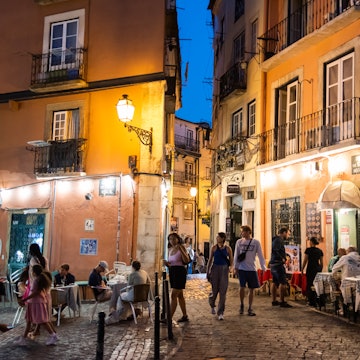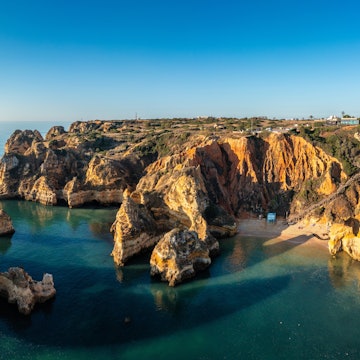
The best times to visit Portugal



Sunset over Porto. Dmitry Rukhlenko/Shutterstock
Portugal has a packed calendar of traditional celebrations, decadent food festivals, outdoor concerts and many other events. Summer is the time to catch the biggest range of activities, but in truth, there’s always something happening here.
Festivals aside, it’s not easy to pin down the best month to visit Portugal – both because it generally has good weather (the country claims more than 300 sunny days a year), and it really depends on what you’re after. For outdoor activities in the south, go in winter when the crowds are thinnest, the prices are lowest, and the weather is pleasant but not hot. For beach days with plenty of time in the surf, September and October can be great. A shoulder season visit to the north, when it's not so rainy and there aren't crowds of tourists everywhere, is the perfect time for urban exploration and hiking adventures.
Plan your time in Portugal with this seasonal guide.

Summer is the best time for the beach and cities
Summer runs June to August in Portugal, and early summer is one of the liveliest times to visit, as the festival calendar is packed. Warm, sunny days are the norm, and while tourism picks up, the hordes have yet to arrive.
June in particular is a party month in Portugal’s largest cities, with Lisbon's nearly month-long Festas de Lisboa (also known as Santos Populares) taking place, and Porto’s equivalent, Festa de São João, held at the end of the same month.
In the Algarve, water temps and crowds both peak in July and August, so plan on sharing those pretty beaches with plenty of other sunseekers. Lisbon and Porto also swell with crowds, and prices soar in July and August. Book outdoor dining at terrace restaurants overlooking the seaside, catch open-air concerts and film screenings and browse for treasures at street markets. August is Portugal’s busiest tourist month, and reserving in advance is essential. Expect to be paying more wherever you go though, as accommodation prices typically increase by 30% or more during the summer high season.

Low season is best for budget travelers
If you want to escape the crowds and enjoy rock-bottom prices on accommodations, plan your trip for the low season months of November to March. Many museums and other attractions keep shorter hours, though you’ll still find a full lineup of performances in cities and bigger towns. Prepare for changing weather conditions – the country’s rainy season is from October to April, and freezing temperatures at higher elevations. The south, however, has ample sunshine, so it’s a fine season for cliff-top walks in the Algarve.
Stay along the coast in November and you’ll have lovely seaside views all to yourself – but you'll need to pack a light jacket for cooler days and nights, plus the odd rain shower. Long nights and chillier days can’t dampen the Christmas spirit in December, with holiday markets, roasted chestnuts and colorfully decorated squares. Days are mostly pleasant in the south but brisk at night, while the north sees cold, rainy days and nights. January is a peaceful time to visit, though the weather can be patchy and cool. Dia de Reis (Three Kings' Day) brings the Christmas festivities to a close on January 6.
February is one of the quietest times for overseas visitors, meaning you won’t have to book lodging months in advance. It can be quite rainy in the north, and you can even go skiing at Estância de Esqui da Serra da Estrela (Portugal’s sole ski resort). Coastal temperatures are cool but mild.
March days are rainy and chilly in the interior and the north of Portugal, though the south sees ample sunshine. Prices and visitor numbers remain low.

Spring and fall are best for outdoor adventures
During the shoulder seasons of spring and fall, you’ll find mild, often sunny days that are ideal for hikes, bike rides and other outdoor activities. This is a great time to check out Portugal’s top natural wonders without the heavy crowds.
Spring (April to May) arrives with a flourish, bringing warmer temperatures and abundant sunshine in both the north and the south, as well as some major religious holidays, like Holy Week. April sees a profusion of wildflowers in the south, and Easter processions add excitement, as does Liberation Day (April 25), when you can see parades and fireworks in some towns.
Lovely sunny weather makes May an ideal time to visit, especially if you’re hitting a long-distance trail, such as the Via Algarviana or the Rota Vicentina. The crowds are beginning to arrive in Lisbon, Porto and the Algarve, though it’s still a fairly relaxed scene compared to the summertime high season.
The fall (September and October) can be a magical time to visit Portugal, with changing leaves in the north coupled with grape harvests and harvest festivals. As the temperatures cool, head to the vineyards of the Douro, where you can see grape harvesting and treading, and even help out. October is also a great month for bird-watching, with many species passing through en route to Africa during the annual fall migration.
Shifting ocean currents mean that the waters off central Portugal’s coastline are at their warmest (a relative term) during October and November, and these days outside temperatures are also typically warm enough for a dip as late as October. The waves are also at their biggest from October to March, so fall is one of the best times of year for surfers (and enthusiastic wave spectators).















